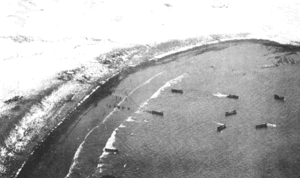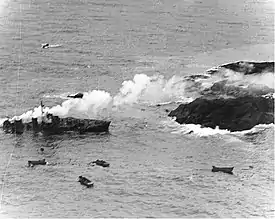Landing at Amchitka
The Landing at Amchitka was the amphibious landing operation and occupation of Amchitka island by American forces during the Aleutian Islands Campaign.[1]
| Landing at Amchitka | |||||||
|---|---|---|---|---|---|---|---|
| Part of the Aleutian Islands Campaign | |||||||
 The American landing at Constantine Harbor, 12 January | |||||||
| |||||||
| Belligerents | |||||||
|
|
(not present) | ||||||
| Commanders and leaders | |||||||
|
| N/A | ||||||
| Strength | |||||||
| 2,100 | N/A | ||||||
| Casualties and losses | |||||||
|
14 killed | N/A | ||||||
Background
In June 1942, the Japanese occupied some of the western Aleutian islands, and hoped to occupy Amchitka.[2] A Japanese survey team scouted the island but rejected it for military purposes.
During the Aleutian campaign an air force base was needed near the occupied islands of Attu and Kiska. Amchitcka was ruled out as a possible candidate due to its close proximity only 50 miles away from the island of Kiska. At the War Department's suggestion, an initial reconnaissance of Amchitka was carried out in September 1942, which found that it would be difficult to build an airstrip on the island.[2] Nevertheless, planners decided on December 13 that the airfield "had to be built" to prevent the Japanese from doing the same.[2] A further reconnaissance mission visited Amchitka from 17 to 19 December, and reported that a fighter strip could be built in two to three weeks, and a main airfield in three to four months.[2] In December 1942, plans were drawn out for the landings dubbed "Operation Longview". The operation would scrape together 2,000 immediate U.S military in the Aleutian Islands by the Alaska Defense Command. It was thought through reconnaissance that Amchitka was occupied by a small Japanese military presence. Eager to remove the Japanese, the Joint Chiefs of Staff agreed to move quickly to regain the territory.[3][4]
Landing at Constantine Harbor
The operation was set for January 9, but delayed due to the weather conditions.[5]
American forces made the unopposed landing on the island on January 12, 1943, three days later. Nearly 2,100 troops disembarked in Constantine Harbor without opposition. Their only enemies were the weather, the unpredictable current, and the rock-studded waters through which the landing was made. The destroyer USS Worden was guarding the USS Arthur Middleton as that transport put the preliminary Army security unit on the shores of Constantine Harbor, Amchitka Island. The destroyer maneuvered into the rock-edged harbor and stayed there until the last men had landed and then turned to the business of clearing the harbor. A strong current, however, swept Worden onto a pinnacle that tore into a hull beneath the engine room and caused a complete loss of power. The destroyer then broached and began breaking up in the surf; Comdr. William G. Pogue, the destroyer's commanding officer, ordered abandon ship; and, as he was directing that effort, was swept overboard into the wintry seas by a heavy wave that broke over the ship. Pogue was among the fortunate ones, however, because he was hauled, unconscious, out of the sea. Fourteen of the crew drowned.
Once on the ground the island was cleared and found to be empty of Japanese military.[6][7]

During the first night ashore a "willowaw" (a violent squall) smashed many of the landing boats and swept a troop transport aground. On the second day a blizzard wracked the island with snow, sleet, and biting wind. Lasting for nearly two weeks, the blizzard finally subsided enough to reveal to a Japanese scout plane from Kiska the American beachhead on Amchitka. Harassed by bombing and strafing attacks from Kiska, engineers continued work on an airfield on Amchitka completing it in mid-February. Japanese attacks on the island then sharply declined. By February 16, the fighter strip was ready for limited operation. On that day eight P-40's arrived on Amchitka, and within a week they were running patrols over Kiska.[8][9]
The stage was now set for the next phase of operations, amphibious attacks to eject the Japanese from their Aleutian footholds.[10]
References
- WILLIWAW WAR (C) The Arkansas National Guard in the Aleutians in World War II. University of Arkansas Press. 1992. ISBN 9781610754644.
- Conn, Stetson (2000). "Chapter X: Alaska in the War, 1942". Guarding the United States and its outposts. United States Army Center of Military History. ISBN 0-16-001904-4. LCCN 62-60067. CMH 4–2. Retrieved 2006-10-09.
- Chandonnet, Fern (2007-09-15). Alaska at War, 1941-1945: The Forgotten War Remembered. University of Alaska Press. ISBN 9781602231351.
- MacGarrigle, George L. (October 2003). Aleutian Islands. The Campaigns of World War II. United States Army Center of Military History. CMH Pub 72–6, paper, GPO S/N 008-029-00232-9. Retrieved 2006-10-07.
- Kohlhoff, Dean (2011-05-15). Amchitka and the bomb: nuclear testing in Alaska. University of Washington Press. ISBN 9780295800509.
- "USS Worden (DD 352) Home". dd352.us. Retrieved 2015-12-27.
- "Chapter X: Alaska in the War, 1942". www.history.army.mil. Retrieved 2015-12-27.
- Morison, Samuel Eliot (2001-11-01). History of United States Naval Operations in World War II: Aleutians, Gilberts and Marshalls, June 1942 - April 1944. University of Illinois Press. ISBN 9780252070372.
- "Researcher digs into the stories of Amchitka's fallen WWII fighters". Alaska Dispatch News. Retrieved 2015-12-27.
- The Army Air Forces in World War II, Volume Four: The Pacific, Guadalcanal to Saipan, August 1942 to July 1944. DIANE Publishing. ISBN 9781428915893.
